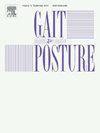标记物放置对经股骨骨整合假体使用者角运动学的影响-纵向病例系列研究
IF 2.2
3区 医学
Q3 NEUROSCIENCES
引用次数: 0
摘要
在仪器步态分析中使用Helen Hayes模型的生物力学数据的准确性会受到软组织伪影(STA)的显著影响。研究问题:在经股骨整合假体步态分析中,如何量化STA并提高角运动学的准确性?方法为了量化STA与大腿标记的相关性,我们检查了12个数据集,其中植入物标记被添加到Helen Hayes标记集中,放置在4个经股骨整合假体使用者的大腿段。该标记位于从股骨延伸的植入物连接处。我们的目的是确定在使用植入物、膝关节内侧或大腿标记物时,步态中计算的运动范围(ROM)的差异。结果表明,除了一名参与者外,所有参与者的髋关节旋转和膝关节内翻/外翻的ROM在不同标记之间存在显著差异(p <; .05)。大腿和植入物标记物之间的髋关节旋转差异在一名参与者中超过10˚,在另外两名参与者中约为5˚。三名参与者的膝内翻/外翻ROM指标差异在3˚至9˚之间。大多数参与者在髋关节屈曲/伸展、髋关节外展/内收或膝关节屈曲/伸展方面没有发现显著差异。意义:在经股骨骨整合假体使用者中使用植入物标记比使用大腿标记更准确地跟踪股骨。由于观察到膝关节内侧和植入物标记物之间的角度运动学相似,对于骨整合股骨假体使用者,应使用膝关节内侧或植入物标记物替代大腿标记物。本文章由计算机程序翻译,如有差异,请以英文原文为准。
Impact of marker placement on angular kinematics in transfemoral osseointegrated prosthesis users — A longitudinal case-series study
Background
The accuracy of biomechanical data using a Helen Hayes model in instrumented gait analysis can be significantly affected by soft tissue artifacts (STA).
Research question
How can STA be quantified and the accuracy of angular kinematics be improved in transfemoral osseointegrated prosthesis gait analysis?
Methods
To quantify STA associated with the thigh marker, we examined 12 data sets for which an implant marker was added to the Helen Hayes marker set, placed on the thigh segment of four transfemoral osseointegrated prosthesis users. This marker was located on the implant connection extending from the femur. We aimed to identify differences in the calculated range of motion (ROM) during gait when using implant, medial knee, or thigh markers.
Results
The results indicate significant differences in ROM for hip rotation and knee varus/valgus between markers for all but one participant (p < .05). Hip rotation differences between the thigh and implant markers exceeded 10˚ for one participant and were about 5˚ for two others. Knee varus/valgus ROM differences between markers ranged from 3˚ to 9˚ for three participants. No significant differences were found for hip flexion/extension, hip abduction/adduction, or knee flexion/extension for most participants.
Significance
Using an implant marker in transfemoral osseointegrated prosthesis users results in more accurate femoral tracking than using the thigh marker. Due to the similarity in angular kinematics observed between the medial knee and implant markers, the medial knee or the implant marker should be used as an alternative to the thigh marker for osseointegrated transfemoral prosthesis users.
求助全文
通过发布文献求助,成功后即可免费获取论文全文。
去求助
来源期刊

Gait & posture
医学-神经科学
CiteScore
4.70
自引率
12.50%
发文量
616
审稿时长
6 months
期刊介绍:
Gait & Posture is a vehicle for the publication of up-to-date basic and clinical research on all aspects of locomotion and balance.
The topics covered include: Techniques for the measurement of gait and posture, and the standardization of results presentation; Studies of normal and pathological gait; Treatment of gait and postural abnormalities; Biomechanical and theoretical approaches to gait and posture; Mathematical models of joint and muscle mechanics; Neurological and musculoskeletal function in gait and posture; The evolution of upright posture and bipedal locomotion; Adaptations of carrying loads, walking on uneven surfaces, climbing stairs etc; spinal biomechanics only if they are directly related to gait and/or posture and are of general interest to our readers; The effect of aging and development on gait and posture; Psychological and cultural aspects of gait; Patient education.
 求助内容:
求助内容: 应助结果提醒方式:
应助结果提醒方式:


